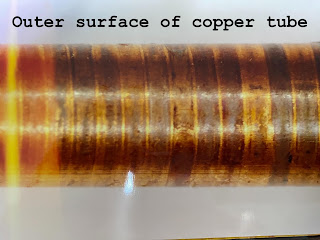วันนี้ผมอยากเสนอการป้องกันการกัดกร่อนโดยการหน่วงไม่ให้เกิดด้วยสารยับยั้งการกัดกร่อน ซึ่งทุกวันนี้มีเทคโนโลยีและสารละลายมากมาย แต่ที่โลกกำลังต้องกันคือ แนวอนุรักษ์ธรรมชาติและสิ่งแวดล้อม...
บทความดังกล่าวเขียนโดย Prof Ali El-Etre (Benha University, Faculty of Science)
Corrosion inhibitors are chemical compounds added to the corrosive medium to reduce the rate of its attack on the metal or alloy. The chemicals which can act as corrosion inhibitors may be inorganic or organic. The inorganic compounds such as chromates inhibit the corrosion process via formation of passive oxide film on the metal surface and thus prevent the corrosive medium to attack the bar metal. On the other hand, the organic compounds adsorb on the metal surface forming a barrier between the metal and the corrosive environment. Some structural features of the organic compounds help them to do so. These include the presence of oxygen, nitrogen or sulfur atoms as well as presence of double bonds. The lone pair electrons of the mentioned atoms facilitate the adsorption process.Some criteria should be considered when making a choice of chemical compounds for inhibition of corrosion. Inhibition of metallic corrosion is mainly an economical process. Therefore, the first criterion must be fulfilled by the used inhibitors is their prices. The other very important criterion should be considered when dealing with corrosion inhibitor is its effect on the human and environment. Unfortunately, most of the effective corrosion inhibitors are synthetic chemicals with high cost. At the same time, the use of such synthetic compounds can cause harm to human and environment.Upon looking around we'll find very rich resources for substances with wide varieties of chemical structures. So, why we rush to synthesize harmful chemical while the nature around us full of the safest ones? The plant is the great chemical factory which can supply us with the chemicals required to inhibit the corrosion process. Most of the naturally occurrence substances are safe and can be extracted by simple and cheap procedures.Recent literature full of researches which test different extracts for corrosion inhibition applications. The examples are numerous such as henna, olive, shirsh zallouh, vanillin, natural honey, khella, onion, ficus, opuntia,many oils extracted from different parts of different plants and many others. Many of these naturally occurring substances proved their ability to act as corrosion inhibitors for the corrosion of different metals and alloys in different aggressive media
Further reading
A.Y. El-Etre, M. Abdallah and Z. E.El-Tantawy, Corros. Sci., vol. 47, No 2, p 385 - 395 (2005).
A.Y. El-Etre, Journal of Colloid And Interface Science, vol. 314, No 2, p 578 – 583 (2007).
A.Y. El-Etre, Materials Chemistry and Physics, vol. 108, No 2-3, 15, p 278-282 (2008).
A. Y. El-Etre, Corrosion Sci., vol. 43, No. 6, p 1031 – 1039, 2001
A. Y. El-Etre, Corrosion Sci., vol. 40, No. 11, p 1845 – 1850, 1998.
A. Y. El-Etre and M. Abdallah, Corrosion Sci., vol. 42, No. 3, p 731 – 738, 2000.
A. Y. El-Etre, Applied Surface Science. vol. 252, No.24, p 8521- 8525 ( 2006).
A. Y. El-Etre, Bull. Electroch., vol. 22, No 2, p 75–80 (2006).
A. Y. El-Etre and Z. El-Tantawy, Portugaliae Electrochim. Acta, vol 24, No 3, p 347 - 356 (2006).
A. Y. El-Etre, Corros. Sci.,vol. 45, No 11, p 2485-2495 (2003).
A.M. Abdel-Gaber, E. Khamis, H. Abo-ElDahab, Sh. Adeel, Materials Chemistry and Physics, Volume 109, Issues 2-3, 15 June 2008, Pages 297-305
.Radojčić, K. Berković, S. Kovač, J. Vorkapić-Furač, Corrosion Science, Volume 50, Issue 5, May 2008, Pages 1498-1504
Pandian Bothi Raja, Mathur Gopalakrishnan Sethuraman, Materials Letters, Volume 62, Issue 1, 15 January 2008, Pages 113-116
Yan Li, Peng Zhao, Qiang Liang, Baorong Hou, Applied Surface Science, Volume 252, Issue 5, 15 December 2005, Pages 1245-1253
B. Müller, Corrosion Science, Volume 44, Issue 7, July 2002, Pages 1583- 1591
D. C. Hansen, S. C. Dexter, J. H. Waite, Corrosion Science, Volume 37, Issue 9, September 1995, Pages 1423-1441
Selected links
http://www.hc-sc.gc.ca/ewh-semt/pubs/water-eau/consultation/corrosion/ part2_6_e.html
สมัครสมาชิก:
ส่งความคิดเห็น (Atom)
การกัดกร่อนกับท่อทองแดงแบบรังมด (Ant-nest corrosion)
วันนี้มีเคสจากหน่วยงานขนส่งมวลแห่งหนึ่งแจ้งว่าท่อทองแดงในระบบเครื่องปรับอากาศเกิดการกัดกร่อนแล้วนำมาสู่การรั่วมาปรึกษา ผมจำได้ว่าเคยวิเคราะห...

-
วันนี้เราเรียนรู้รูปแบบการเสียหายของวัสดุในรูปแบบถัดมา นั่นก็คือ การล้า หรือ Fatigue จะมีรายละเอียดเป็นอย่างไร เชิญติดตามได้เลยครับ คำว่า ...
-
cr : https://doi.org/10.1016/j.ijplas.2023.103601 เมื่อชิ้นส่วนโลหะถูกนำมาใช้งานภายใต้สภาวะอุณหภูมิสูงในขณะเดียวกันก็รับความเค้นแรงดึงไปด้ว...
-
การกัดกร่อนแบบกัลวานิกเป็นรูปแบบหนึ่งของการกัดกร่อนที่เกิดขึ้นเมื่อมีวัสดุที่ต่างกัน 2 ชนิด (เช่น เหล็กกล้าไร้สนิมและแมกนีเซียม) มาเชื่อมทา...



ไม่มีความคิดเห็น:
แสดงความคิดเห็น